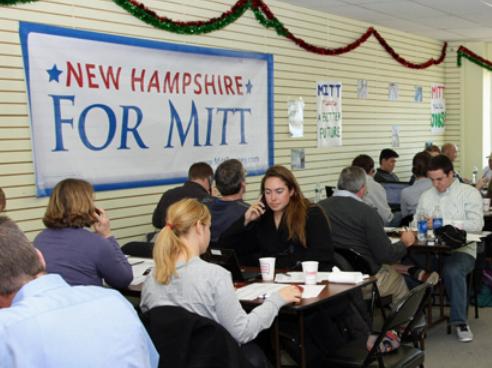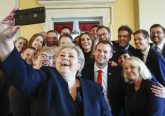So Mitt Romney won what the Washington Post calls a “decisive victory” in Florida yesterday, and while the Republican presidential primary isn’t quite over (a majority of the votes still went to his three remaining rivals, donations keep coming in to Newt Gingrich especially), the former Massachusetts governor is now well-positioned to lock up the nomination on “Super Tuesday,” March 6, where people in eleven states cast their votes.
 If Romney becomes the candidate, a closer look at his current campaign can help us understand how he will fight the general election. In past cycles, most recently of course in 2008, the way candidates fought their primary gave many clues to how they ended up fighting the general election—in terms of their stage persona and their main message, yes, but also in terms of how their effort was organized in a more practical sense.
If Romney becomes the candidate, a closer look at his current campaign can help us understand how he will fight the general election. In past cycles, most recently of course in 2008, the way candidates fought their primary gave many clues to how they ended up fighting the general election—in terms of their stage persona and their main message, yes, but also in terms of how their effort was organized in a more practical sense.
Building a campaign organization, mobilizing allies around it, and recruiting thousands of low-level staffers and volunteers is not something that is easily done overnight, and the wider campaign build around a particular candidacy will have its own internal inertia and idiosyncrasies, traits that often reflect decisions made months or even years before Election Day on the basis of a combination of received wisdom and the priorities of individual people involved. Once things are done in a particular way, unless something is clearly dysfunctional, intense time pressure and the multiple concerns always calling for the attention of the candidate and senior staff generally mean they continue to be done that way.
Take the 2008 Obama campaign as an example—the kernel was assembled from early 2007 onwards, with staffers plotting strategy and tactics, technologists developing the tools and infrastructures for an extensive, nation-wide effort, and organizers connecting with the multitudes of willing volunteers who helped power Obama to victory in both the primary and the general election. As for example David Plouffe, the campaign manager, has made clear, even as the campaign (both the formal organization and the wider network of allies and volunteers around it) grew and grew, senior staffers were working hard to maintain a basic set of organizing principles and a certain internal ethos that had worked well in the primary. (Sometimes dealing with enthusiastic groundswells of support from people unaccustomed to how campaigns are usually run in a pretty top-down fashion was in fact something of a challenge, as David Axelrod himself has noted.) As my friend Daniel Kreiss shows in his very interesting forthcoming book on the development of the campaign and the technologies and tools it relied on, many of the innovations we today associate with the 2008 Obama campaign where in fact pioneered, tested, and refined in the years before. (Just as the 2000 and 2004 Bush campaigns built on years of experimentation in local and state-level races, orchestrated by Karl Rove.)
On this basis, let’s have a look at just two features of the Romney primary campaign that it will be interesting to follow as we move forward—
- How much volunteer support does Romney actually have? Many commentators have made much of how parts of the Republican base have yet to warm to his candidacy, but beyond a general “mood” amongst the party faithful, can he draw substantial numbers of people to his campaign? Beyond the raw numbers, can his campaign work constructively with these people to make sure that they feel involved and continue to contribute their time and effort? Volunteers have generally been found to be more effective ambassadors for campaigns on the doorstep and over the phone than paid casual workers, so whoever builds the best volunteer operation will have an edge over his rival. (Turnout in US presidential elections has been increasing every cycle since 1996, in part due to increased emphasis on field campaigns. Given the current economic climate and a certain sense of disillusionment, in the absence of major get-out-the-vote efforts on both sides, 2012 may see the first fall in popular participation in sixteen years.)
- How will his campaign work with the volunteers who do come? Throughout the primary, Romney’s campaign has made a priority of having a physical presence on the ground, opening campaign offices and posting contact details in relevant states to make sure people have somewhere to go. His campaign has also embraced the various online-enabled forms of “distributed phone banking” pioneered by MoveOn and others, where supporters can log on via a campaign website and make calls directly to target voters in relevant states from their own smart phone or computer. In both cases, the campaign has quite sensibly been platform agnostic, deciding to make as many different forms of engagement possible and to meet potential volunteers where ever they may come from. In both cases, the campaign has also prioritized channelling people’s time and energy into phone banking, a demonstrably effective way of trying to sway people and turn out voters.
At a general level, coverage of the primary will often stress how Romney’s campaign is well-funded and professionally run. But money and hard-nosed expertise is not all an effective campaign needs. The interface between campaign staffers in it to win it and volunteers with a much wider and mixed set of motivations can generate considerable friction and requires mutual empathy and a practical sense for making people work together that is sometimes lacking from political campaigns. And it matters. Volunteer mobilization and the translation of volunteers’ time and effort into instrumentally useful activities may sound dry and dull in comparison to the more immediately exciting speculation about what the next campaign advertisement will highlight or how the candidate will perform in the next debate. But both are crucial parts of a competitive campaign and shape how it is possible for ordinary people to take part in the electoral process beyond casting their vote. That’s why it will be interesting to see how the eventual Republican nominee ends up organizing his effort to challenge Obama’s re-election campaign.
My book, Ground Wars: Personalized Communication in Political Campaigns, deals with how American political campaigns mobilize, organize, and target their field operations, using large numbers of volunteers and paid part-timer workers to contact voters at home at the door or over the phone. It has just been published by Princeton University Press and is available on Amazon.
(cross-posted on rasmuskleisnielsen.net)








2 Comments